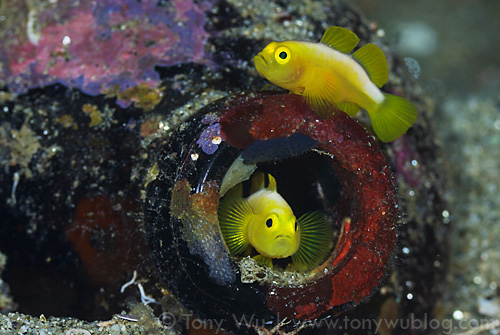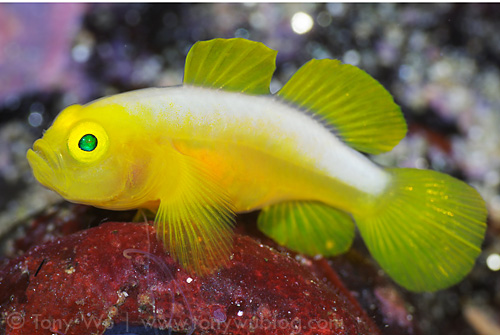We’ve just arrived back in Alotau, after another terrific journey of exploration aboard Golden Dawn, which took us first to the Cape Vogel area, over to Goodenough Island, around Fergusson Island, through the strait between Fergusson and Normanby, and finally to the fantastic reefs around Nuakata Island.
Bob, Wen-Tsae and Eric have just left for the airport. The rest of us will be catching flights in the next day or two.
Without a doubt, one of the highlights of this trip for me was having the opportunity to see and photograph Lubricogobius dinah, an irresistibly cute yellow-and-white goby:

Pair of Dinah's gobies (Lubricogobius dinah) with their beer-bottle home,
at Observation Point in Milne Bay Province, Papua New Guinea
I can’t remember the exact circumstances under which I first came across a reference to these fish, but I’m pretty sure it was over a decade ago. What I do recall however, is my gut reaction at the time, which was something like: “I like!”, with a big, silly grin plastered across my face.
Anyway, it’s a good thing I have an obsessive personality, because it’s taken me this long to find and photograph a pair.
This fish is named after Bob’s wife Dinah, who is as nice a person as these fish are cute. When we reached a dive site known as Observation Point on Normanby Island, Bob took me down to look for several beer bottles he placed here in the past, where these gobies often take up residence.
Given how long I’ve waited to see these fish, I was anxious...anxious that we might not find any gobies, and if we did, that I might screw up the photos, as these fish are small, skittish, and live down at 30 metres or more. They have a tendency duck inside their homes at the slightest disturbance. When you’re down deep, there’s not a lot of time to twiddle thumbs while you wait.
The first bottle we checked was a blank, but the second was occupied. Bob left me at 30 metres, where I spent 40 minutes approaching fish.
If you’re a diver, you’re probably thinking, “40 minutes at 30 metres? That’s serious deco time.”
It was.
Actually, I was on a rebreather, which was a big help...first because it helped to minimise sounds associated with exhalation, and second, because it allowed me to maintain a high PPO2 and stay down longer with minimal nitrogen saturation. (Almost sounds like I know what I’m talking about, doesn’t it?). Anyway, the upshot is that without the rebreather, I would’ve been significantly more time-restricted and nitrogen-loaded, and the sound of bubbles may have kept the fish from growing comfortable with my presence.
Even with the relative silence of a rebreather, the gobies ducked into the bottle as soon as I approached, but after I waited 10 to 15 minutes, they came out again. Little-by-little I closed the distance, until I was near enough to nail a few images like this:

Super-macro shot of Dinah's goby (Lubricogobius dinah)
[Behavioural note: When the gobies eventually grew accustomed to my presence, one (always the same individual) stayed in the bottle all the time. The other fish swam outside, often perching atop the bottle entrance, but more often, hovering five to 10 centimetres above the bottle, swimming in a slightly twitchy fashion, reminiscent of how dart gobies move. I’m not sure if anyone else has ever seen this behaviour before, as the goby only started swimming above the bottle when it seemed completely at ease with me.]
When preparing for the dive, I knew that this would be a one-time opportunity. If we found the fish, I’d have one chance, and one chance only, as we were planning to move on to another site after the dive.
With a bit of deliberation, I chose to use a super-macro set-up, because I wasn’t sure how close the gobies would allow me to approach. I figured that with a 3x teleconverter + 100mm macro lens + Canon 5D Mark II camera, I would be able to maximise image magnification, even at a considerable distance. Of course, with the loss of light from the teleconverter and the inherently dark conditions at 30m in muck, it was nearly impossible to see.
I took a Sola 600 light down with me and used the red focusing light. Fortunately, that provided sufficient illumination for me to focus manually, and the red light didn’t seem to bother the fish.
So...after 40 minutes of lying at 30 metres on the bottom of the ocean, crawling centimetre by centimetre, using a KISS rebreather, wielding a super-macro lens set-up and aiming with a Sola 600 light, I slam-dunked a series of shots I’ve been pursuing for more than 10 years...thanks, of course, to Bob’s sage advice and impeccable fish-spotting talent.
(Disclosure: Sola 600 provided by Scubacam and Light and Motion)